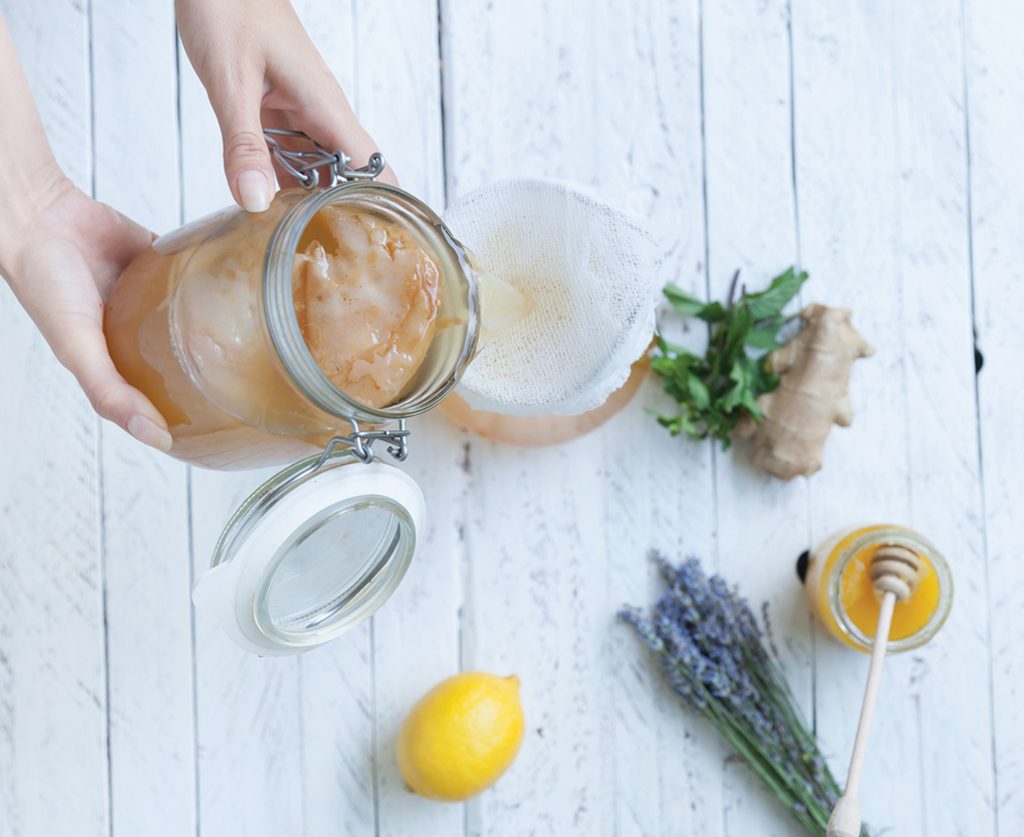MORE AND MORE SINGAPOREANS ARE FERMENTING THEIR OWN FOOD AND DRINKS AT HOME, HOPING TO REAP THE HEALTH BENEFITS OF PROBIOTICS, OR ‘GOOD’ BACTERIA. WITH THESE TIPS, YOU CAN TOO!

Fermentation has been used throughout history by different cultures and civilisations. It is essential in the production of wine and beer, the leavening of bread, food preservation, as well as pickling of foods with vinegar. As Singaporeans, we are no strangers to fermented foods and condiments, such as tempeh, soya sauce, miso, kimchi and fish sauce, among many others. However, we may not be as familiar with fermented drinks such as kombucha and kefir.
Kombucha and kefir are believed to provide probiotics associated with improving gastrointestinal health. They are produced from starter cultures that can be reused and even grown so that you can have a lifetime supply of probiotic beverages.
KOMBUCHA
What it is: Kombucha is a fermented tea that supposedly originated in China around 220BC before appearing in Russia and Europe. It is brewed using a scoby, short for ‘symbiotic culture of bacteria and yeast’, which resembles a brownish fibrous tissue. The scoby starts the fermentation process by feeding on sugar.
How to make: Brew tea, stir in sugar and add scoby. The kombucha is fermented in a glass jar. Black tea or greentea is typically used. The fermentation may take 15–28 days in the beginning, with subsequent batches reduced to 7–14 days, depending on factors such as temperature and water quality.
Benefits: Kombucha is believed to be rich in probiotics, which line your digestive tract to help you absorb nutrients better; probiotics also support your immune system to protect against infection and illness. It is suitable for vegans; however, the fermentation process produces small amounts of alcohol.
Taste: Slightly fizzy tea with sweet and sour notes. You can experiment with a variety of flavours by using the kombucha in a second fermentation with fruits, spices or herbs.
Note for beginners: Start with half a cup a day or approximately 118ml. If you have health issues, discuss with your doctor before consuming.
WATER KEFIR
What it is: Water kefir is made with kefir grains, which are actually clusters of bacteria, yeast, and polysaccharide that look like ‘grains’ of jelly. These grains are said to have originated from Tibet, the Caucasus Mountains and the southern peninsula of Ukraine.
How to make: Add the grains to boiled and cooled water mixed with sugar. Cover with a towel or paper coffee filter and leave in a cool, dark place for its first fermentation of 24–48 hours. Strain the grains and use them to start another batch or put to sleep in the fridge. You can drink the water kefir or flavour it in a second fermentation with your choice of fruits or fruit juice for a further 12–24 hours at room temperature. Discard the fruit pulp, if any, and store in fridge to cool.
Benefits: Water kefir has a beneficial culture of microbes that consumes the simple sugars in your sugar water base to create a probiotic drink. As it feeds on the sugar, the final product does not contain as much sugar. Sweetening it with fruits makes it a healthier alternative to soft drinks.
Taste: Less acidic than kombucha, non-caffeinated, and slightly fizzy with sweet and sour notes. Can be flavoured with your choice of fruits and juices.
Note for beginners: Start small. Water kefir also contains a small amount of alcohol, so consider drinking it at lunch or dinner. Begin with 1/8 of a cup a day, or approximately 30ml, and increase intake gradually.
MILK KEFIR
What it is: Milk kefir is a tangy, yoghurt-like drink believed to have originated from the North Caucasus mountains. It is made from milk kefir grains, which have a cauliflower-like texture and appearance.
How to make: Add one to two teaspoons of grains to four cups of fresh milk. Cover with a paper coffee filter or butter muslin and leave in a cool, dark place for a minimum of 12 hours. Strain the grains and drink the milk kefir as is, or sweeten with your choice of fruits. Use the grains to start another batch or put to sleep in the fridge. You can even strain out the whey to make cottage cheese.
Benefits: Milk kefir grains contain about 30 strains of bacteria and yeasts, and are believed to be a more potent source of probiotics than yoghurt. The probiotic Lactobacillus kefiri is unique to kefir; studies have shown it can inhibit the growth of various harmful bacteria, including salmonella, H. pylori and E. coli. Some dog owners feed their pets milk kefir to reduce yeast overgrowth and ease allergies.
Taste: Milk kefir tastes tangy, like yoghurt, but has the consistency of a creamy drink.
Note for beginners: Start small. Begin with 1/8 cup a day, or approximately 30ml, and increase intake gradually. It makes a great breakfast drink.
SAFETY TIPS
- Always wash your hands and keep your work surface and equipment clean.
- Use different utensils for different cultures to prevent cross-contamination.
- The bottles and containers for your kombucha and kefirs should be made of glass. They should be washed in hot, soapy water, rinsed well and dried before use.
- Strainers used for your grains and scoby should be made of plastic. Avoid letting your grains or scoby come in prolonged contact with metals as they may react with the acidic nature of these cultures.
- For kombucha and water kefir, use water that has been boiled and cooled to get rid of chlorine, which can kill microbes and prevent fermentation.







